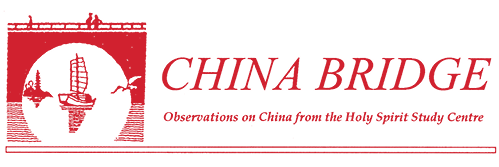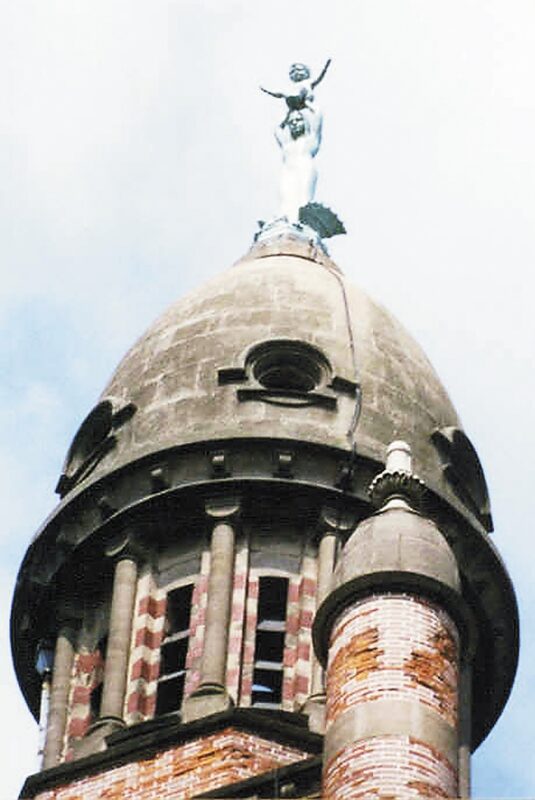
China Bridge (神州橋樑)_2008/May
Pilgrimage during the month of Mary
A few years ago, in the United States of America (US), some boys went camping in a forest. Their guide said, “Look up in the sky! An eagle!” The boys raised their heads for a glance and then they looked away in boredom. The man asked, “Aren’t you impressed? That’s an eagle!” One boy replied, “Yes, but I’ve seen it before.” The guide asked in surprise, “Where did you ever see an eagle before?” The boy answered, “On television – and it was bigger.”
What’s wrong with that picture? Human beings have bodies, not just souls. We are not disembodied intellects. A century ago, a few bookworms spent endless hours reading, but that was not considered healthy. Today, the temptation is to devote the majority of one’s waking life to television or to the Internet.
Yet, it is far better physically, emotionally and spiritually to stand up and walk. Rather than reading about an important place, or viewing a video, there is something life enhancing about going to the trouble of visiting it in person. There were pilgrims in the world long before there were tourists.
Pilgrimage in the Bible and in the Catechism
Moses ascended Mt. Sinai to receive the Ten Commandments (Ex. 19-20). Centuries later, the prophet, Elijah, climbed the same mountain, after undergoing a time of crisis and discouragement. On the summit, he received a revelation and an assignment (1 Kgs. 19:1-20). While Jerusalem has a dry climate, at least it is greener and more accessible than the interior of the Sinai Peninsula.
Pilgrims rejoiced to go up to the house of the Lord (Ps. 122) and pray in the holy temple. Gentiles came from as far away as Ethiopia to worship in Jerusalem (Acts 8:26-40). However, the Samaritans argued passionately that Mt. Gerizim was God’s holy mountain. Seeking to worship God in spirit and in truth (Jn. 4:20-24), Christians have emphasised the person of Jesus more than any earthly piece of real estate. Pilgrimages to Jerusalem, Rome, or some other sacred site have never been mandatory for Christians, not even for those with good health and money.
Nevertheless, the overall view of pilgrimage found in the Catechism of the Catholic Church is positive. “The religious sense of the Christian people has always found expression in various forms of piety surrounding the Church’s sacramental life, such as the veneration of relics, visits to sanctuaries, pilgrimages, processions…” (n. 1674). There is a need for pastoral discernment “to sustain and support popular piety and, if necessary, to purify and correct the religious sense which underlies these devotions…” (n. 1675).
Regarding devotion to Our Lady, some reported Marian apparitions turn out, after close examination, to be a distortion of the Catholic faith, or even fraudulent. Sometimes, the local bishop has to discourage pilgrimages. The need to purify ritual activity such as pilgrimages, feasts and sacrifices goes back to ancient times. “Ritualism often encouraged an excessively external worship. The people needed education in faith and conversion of heart; this was the mission of the prophets, both before and after the Exile” (n. 2581).
As a sign of respect and love for the divine majesty, Christians may make promises to God, such as a promise to go on a pilgrimage (n. 2101). Yet people have been known to rashly promise something they cannot possibly do, so there are ways of dispensing them from such promises (n. 2103).
‘Red tourism’ in mainland China
Although the Communist Party was founded in Shanghai in 1921, it took root in rural areas after 1927 and grew in the Jiangxi Soviet in the Jinggang Mountains (江西井崗山). During the Long March of October 1934 to November 1935, a vital planning meeting was held in Zunyi in Guizhou (貴州遵義). The terminus of the Long March, Yanan, Shaanxi, (陝西延安) was the communist capital until the founding of New China in 1949.
In both Zunyi and Yanan, the local Catholic property was appropriated for Party meetings. Since these two churches are now Communist museums, it took many years to get permission to build another Catholic church in town, but that finally happened. The geography and events of 1921-1949 shaped a distinctly Chinese form of communism.
In July 2005, Red tourism was in the news in China. Tourists were told of 100 “classic Red tourist areas” to visit where they could see the history of the pre-1949 revolution in person.
Tourists rent Red Army uniforms and pose for photos in historic spots. Red tourism is meant “to uplift the national ethos, serve ideological and patriotic ends” and also “to eulogise the brilliant cause of the Party.”
In addition, most of the Revolutionary Base Areas back then were poor, even by the standards of Old China, and now they are still relatively poor. So attracting Red tourists gives the local economy a needed stimulus.
At the end of 2007, news reports said that 400 million Red tourists had spent 100 billion RMB ($111.3 billion). This economic boost has created two million jobs in 12 major and 88 lesser locations. Yet, some old veterans grumble about the propriety of making money from the memory of revolutionaries, who were totally opposed to capitalism.
Red tourism is up and running for now. Time will tell if people a few generations later will still feel “moved by the spirit” to set out as Red tourists.
May 24 and the papal letter

Pope Benedict issued a public letter on 30 June 2007 to all the Catholics in China. But near the end, the Holy Father switched target audiences. “Dear pastors and all the faithful, the date May 24 could in the future become an occasion for the Catholics of the whole world to be united in prayer for the Church which is in China.” That is the feast of “Mary Help of Christians, who is venerated with great devotion at the Marian shrine of Sheshan in Shanghai” (n. 19).
He continues, speaking to the global Church, reminding all Catholics to “love our enemies and to pray for those who persecute us.” In conclusion, the pope speaks again, specifically to the Catholics of China, and quotes 1 Peter 1:6-7 on gold tested in fire. In asking for the intercession of Mary, “Mother of the Church and Queen of China,” he pictures her waiting silently at the cross, while hoping for the resurrection.
Catholics in China were thankful to receive the attention and care of the Holy Father. Yet, some other people grumbled. If the pope prays for China, does that mean he has a low opinion of China? Not at all! Catholics have always prayed for neighbours both near and far away. Like it or not, human life in every part of the world is marked by suffering, incompleteness and even sin. Everybody needs prayers.
Week after week, the pope greets international pilgrims in Rome and asks a blessing from heaven on their homeland. Perhaps, if it were easier for Chinese Catholics to visit Rome, then the papal letter would not have singled out one particular shrine in Shanghai.
Catholics in Shanghai were overjoyed at the mention of Sheshan and began to plan for extra pilgrims on May 24. Then, as this Olympic year progressed and crowd control became more of a concern than usual, there were conflicting reports as to how many people would actually be able to climb that hill on the feast day.
Opposition to prayer and pilgrimage
Not long ago in the US, a Mr. A said to a Mr. B, “I’ll pray for you.” Mr. B was an atheist and he felt insulted by the comment. So he took legal action to prohibit Mr. A from praying for him. The judge quickly dismissed the motion. The judge could have asked, “If you are an atheist and do not believe in the power of prayer, then how can prayer hurt you?”
“If Mr. A wants to waste his breath praying for you, why should I stop him?” But instead the judge asked, “How can any court issue a restraining order against prayer? How can we possibly enforce it?”
Mr. B felt that Mr. A had passed a moral judgment against him and adopted a superior attitude in lifting him up to the Lord in prayer. But Mr. B had no legal grounds for action. The case might be otherwise if Mr. A had bussed thousands of people to pray in front of Mr. B’s house, blocking his door.
In China, large crowds and traffic control likewise draw the attention of the police. Some Catholic shrines have told pilgrims to avoid the actual feast day, or even to come during a more convenient month. Holy places linked to the unofficial Church communities have long been under surveillance. So the faithful have to reschedule their calendars and their destinations accordingly.
In China, before people do anything, they first ask themselves: “What will the communists say?” In the US, the first question is: “What will the lawyers say?” In every nation, religion has to adapt to the wider culture and society to at least a certain extent. In turn, never underestimate the power of faith to change a culture.
As this article goes to print, China Bridge does not have the boldness to predict the short-term future. Yet, it is safe to predict that historic places will continue to attract people, century after century. The profit motive and too many stalls selling trinkets will increasingly threaten both Red tourism and religious pilgrimages. People will be ensnared by virtual reality and the ease of viewing a computer screen. But there will always be a dedicated few who would rather see an eagle or a statue on location, rather than on television.
MJS


 ENG
ENG